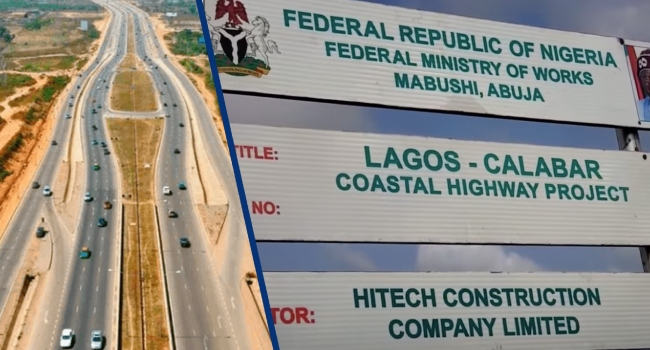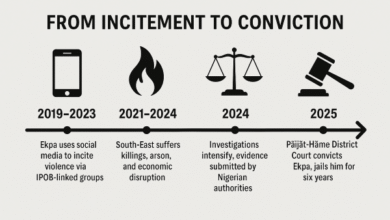Lagos-Calabar Coastal Superhighway: Phase 1 Hits 70% Completion, January 2026 Delivery target

The first phase of Nigeria’s most ambitious infrastructure project in decades—the Lagos-Calabar Coastal Highway—is 70% complete and on track for final delivery by January 2026, according to Minister of Works, Senator Dave Umahi.
During a recent inspection tour of the corridor, Umahi confirmed that the pace of work, technical quality, and financial commitment from partners are “encouraging signs that Nigeria may finally be engineering its way out of decades of infrastructure stagnation.”
“This project is more than just a highway; it’s a backbone for economic transformation, industrial growth, and regional integration along the southern coastline,” Umahi stated during a site review session with representatives of the Dutch Bank and Development Bank of Southern Africa, two of the financial backers.
THE ROAD AHEAD: A NATIONAL STRATEGIC ASSET IN MOTION
The Lagos-Calabar Coastal Highway is not merely a transport route—it is designed as a catalyst for long-term economic expansion, running parallel to Nigeria’s southern shoreline and connecting key states, industrial zones, ports, and tourist destinations.
The first phase of the 700km superhighway, spanning 20 kilometres from Ahmadu Bello Way in Lagos, is expected to be fully paved and structurally completed by May 2025—ahead of projections. What is particularly notable is that contractors have achieved 70% of the first-phase scope despite receiving less than 70% of the funding, indicating an extraordinary level of operational efficiency and national commitment.
“That is why I call them people set on nation-building, not just profit-making,” Umahi remarked, praising Hitech Construction Company for its performance.
BRANDECONOMY INSIGHT: WHY THIS HIGHWAY IS A BIG DEAL
Few infrastructure projects in Nigeria’s recent history have matched the scope, scale, or symbolism of the Lagos-Calabar Coastal Highway. The corridor is not only expected to reduce travel time, but it is also envisioned as a development artery, unlocking coastal real estate for tourism, housing estates, industrial hubs, and logistics parks.
With concrete pavement thickness of 280mm (surpassing the 275mm design spec) and multiple interchanges and flyovers planned, the highway is engineered to withstand heavy-duty traffic and climate impact—particularly critical for a route running along the Atlantic coastline.
STRUCTURAL PLANNING: FROM HOUSES TO HIGHWAY – A GROWING CHALLENGE
One of the challenges flagged by the Minister is the potential for unregulated local access, with motorists joining the highway “from their houses”—a euphemism for urban sprawl and informal access points that could threaten safety and disrupt the flow of traffic.
To mitigate this, Umahi said the design team is reworking plans to introduce barriers, retaining walls, and controlled access points via flyovers and interchanges, in line with international best practices for expressway systems.
“It’s a superhighway, not a regular street. We must protect it from future chaos,” Umahi emphasized.
FINANCING & STRATEGIC BACKING: A NEW MODEL FOR PROJECT DELIVERY
The involvement of foreign financial promoters, including Dutch and South African institutions, signals a growing shift in Nigeria’s infrastructure financing model—from exclusive government funding to blended capital structures involving sovereign guarantees, concessional lending, and performance-based contracts.
This aligns with the Tinubu administration’s push for Public-Private Partnerships (PPPs) and strategic financing to bridge Nigeria’s $100 billion infrastructure gap, particularly in roads, rail, ports, and power.
BRANDECONOMY ANALYSIS: WHAT TO WATCH NEXT
✅ January 2026 Completion: The timeline will serve as a litmus test for Nigeria’s ability to execute mega-projects on time and within budget.
✅ Real Estate Boom Along the Corridor: Already, land values along the axis are spiking, with speculators and developers circling locations from Lagos to Lekki Free Trade Zone.
✅ Access Control Strategy: The final highway design will be closely watched for how it handles security, tolling, logistics hubs, and rural-urban linkages.
✅ Economic Impact Measurement: Upon completion, analysts will be monitoring metrics like reduced logistics costs, improved trade throughput, and coastal tourism growth.
CONCLUSION: A NATION-BUILDING ROADMAP IN CONCRETE
The Lagos-Calabar Coastal Highway is not just an infrastructure project—it is an audacious nation-building venture that, if sustained, could redefine mobility, investment and industrial competitiveness across southern Nigeria.
In a nation where projects often begin with fanfare and fizzle out, the steady pace, financial discipline, and structural quality of this project offer cautious optimism that Nigeria may finally be building roads that lead somewhere—economically and symbolically.











